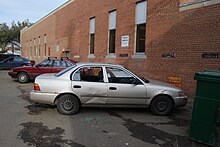194:
22:
142:
166:
Value refers to how much a particular target is worth to the offender and it differs based on the person. Inertia simply refers to the size and weight of the target, which is why smaller goods are usually stolen versus bigger items. Visibility refers to the target being exposed to the offender, and
215:
Some violent crimes can also be considered a crime of opportunity. Variables such as whether or not female or middle-aged people are present can affect an individual's response to a perceived insult. Other variables like group size and size of the individual affect whether or not an offender may
189:
Nodes refers to the places people travel to and from and the crime generated in specific areas, for example bars, malls, parks, where people work, and the neighborhoods in which people live. Paths refers to the paths between nodes or areas that victims and offenders frequent, crime is frequently
206:
This theory focuses on the offender's ability to make choices, based on the assumption that the offenders actions are purposeful. Offenders consider the benefits and risks and make choices based on the opportunities to commit a crime.
190:
linked to flows of people among paths such as commuter times, establishment's closing times, and school being out for the day. Edges are the outer boundaries of certain areas, where outsiders of a neighborhood usually commit crimes.
138:
This theory focuses on the right circumstances for a crime of opportunity to occur. The three main components of this theory emphasize an offender, suitable target and the lack of a capable guardian.
126:
that is committed without planning when the perpetrator sees that they have the chance to commit the act at that moment and seizes it. Such acts have little or no
216:
initiate a violent act. Larger groups will have the tendency to attack smaller groups and larger individuals will be more likely to attack smaller ones.
167:
thus making the target of value known to the offender. Access refers to how easily offenders can get to a target and what obstacles might impede them.
224:
In order to reduce these types of crimes minimizing opportunities is the most common idea. Several methods are used to reduce opportunity:
291:
86:
58:
39:
65:
72:
105:
175:
This theory emphasizes the environment that these crimes occur in. There are three major components of this theory.
54:
43:
236:
228:
79:
32:
332:
337:
302:
8:
149:
There are four main points that influence the likelihood of someone being targeted.
193:
326:
127:
242:
All of these methods are used to reduce opportunities for specific targets.
21:
292:"Opportunity Makes the Thief Practical theory for crime prevention"
141:
123:
299:
Policing and
Reducing Crime Unit: Police Research Series
46:. Unsourced material may be challenged and removed.
324:
201:
133:
106:Learn how and when to remove this message
192:
140:
170:
325:
289:
220:Reducing opportunities and prevention:
285:
283:
281:
279:
277:
275:
273:
271:
269:
267:
265:
263:
261:
259:
257:
255:
44:adding citations to reliable sources
15:
13:
14:
349:
252:
210:
290:Felson, Marcus (November 1998).
20:
31:needs additional citations for
301:. paper 98: 36. Archived from
1:
245:
233:defensible space architecture
237:situational crime prevention
7:
202:Rational Choice perspective
197:Vehicle with broken window.
10:
354:
229:problem-oriented policing
134:Routine activity theory
198:
146:
55:"Crime of opportunity"
196:
144:
171:Crime Pattern theory
120:crime of opportunity
40:improve this article
145:Looting of a store.
199:
147:
116:
115:
108:
90:
345:
317:
316:
314:
313:
307:
296:
287:
111:
104:
100:
97:
91:
89:
48:
24:
16:
353:
352:
348:
347:
346:
344:
343:
342:
323:
322:
321:
320:
311:
309:
305:
294:
288:
253:
248:
213:
204:
173:
136:
112:
101:
95:
92:
49:
47:
37:
25:
12:
11:
5:
351:
341:
340:
335:
319:
318:
250:
249:
247:
244:
240:
239:
234:
231:
212:
211:Violent Crimes
209:
203:
200:
187:
186:
183:
180:
172:
169:
164:
163:
160:
157:
154:
135:
132:
114:
113:
28:
26:
19:
9:
6:
4:
3:
2:
350:
339:
336:
334:
333:Crime by type
331:
330:
328:
308:on 2018-06-19
304:
300:
293:
286:
284:
282:
280:
278:
276:
274:
272:
270:
268:
266:
264:
262:
260:
258:
256:
251:
243:
238:
235:
232:
230:
227:
226:
225:
222:
221:
217:
208:
195:
191:
184:
181:
178:
177:
176:
168:
161:
158:
155:
152:
151:
150:
143:
139:
131:
129:
128:premeditation
125:
121:
110:
107:
99:
88:
85:
81:
78:
74:
71:
67:
64:
60:
57: –
56:
52:
51:Find sources:
45:
41:
35:
34:
29:This article
27:
23:
18:
17:
310:. Retrieved
303:the original
298:
241:
223:
219:
218:
214:
205:
188:
174:
165:
148:
137:
119:
117:
102:
93:
83:
76:
69:
62:
50:
38:Please help
33:verification
30:
338:Criminology
327:Categories
312:2018-05-05
246:References
159:Visibility
96:March 2008
66:newspapers
156:Inertia
80:scholar
162:Access
82:
75:
68:
61:
53:
306:(PDF)
295:(PDF)
185:Edges
182:Paths
179:Nodes
153:Value
124:crime
122:is a
87:JSTOR
73:books
59:news
42:by
329::
297:.
254:^
130:.
118:A
315:.
109:)
103:(
98:)
94:(
84:·
77:·
70:·
63:·
36:.
Text is available under the Creative Commons Attribution-ShareAlike License. Additional terms may apply.

